Analyzing the Global Economic Effects of US Monetary Policy and M&As
VerifiedAdded on 2023/04/22
|14
|3820
|309
Homework Assignment
AI Summary
This paper examines the repercussions of the US Federal Reserve's monetary policy transitions on both the US economy and the global landscape, particularly focusing on emerging economies. It analyzes the potential surge in capital inflows driven by interest rate differentials, while also hig...
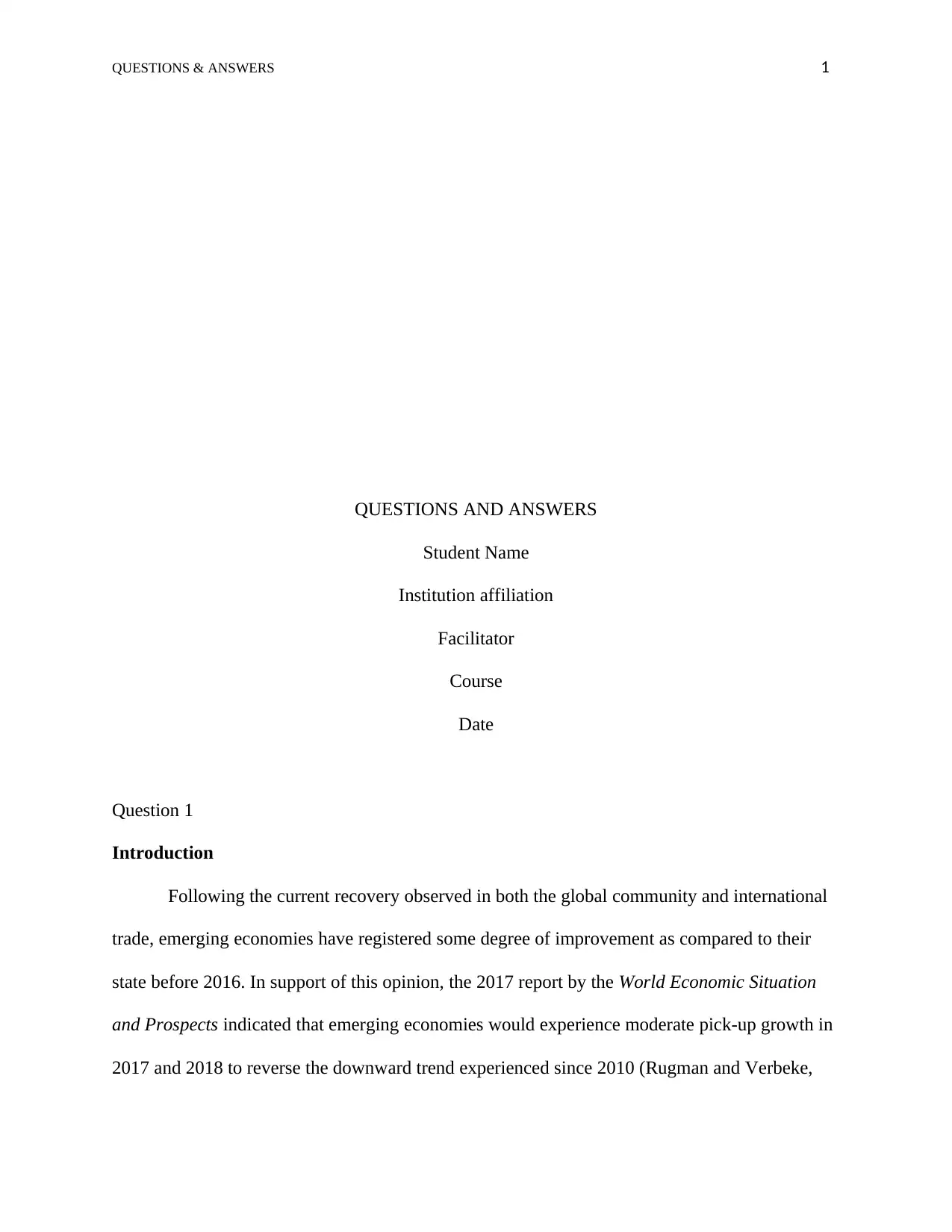
QUESTIONS & ANSWERS 1
QUESTIONS AND ANSWERS
Student Name
Institution affiliation
Facilitator
Course
Date
Question 1
Introduction
Following the current recovery observed in both the global community and international
trade, emerging economies have registered some degree of improvement as compared to their
state before 2016. In support of this opinion, the 2017 report by the World Economic Situation
and Prospects indicated that emerging economies would experience moderate pick-up growth in
2017 and 2018 to reverse the downward trend experienced since 2010 (Rugman and Verbeke,
QUESTIONS AND ANSWERS
Student Name
Institution affiliation
Facilitator
Course
Date
Question 1
Introduction
Following the current recovery observed in both the global community and international
trade, emerging economies have registered some degree of improvement as compared to their
state before 2016. In support of this opinion, the 2017 report by the World Economic Situation
and Prospects indicated that emerging economies would experience moderate pick-up growth in
2017 and 2018 to reverse the downward trend experienced since 2010 (Rugman and Verbeke,
Paraphrase This Document
Need a fresh take? Get an instant paraphrase of this document with our AI Paraphraser
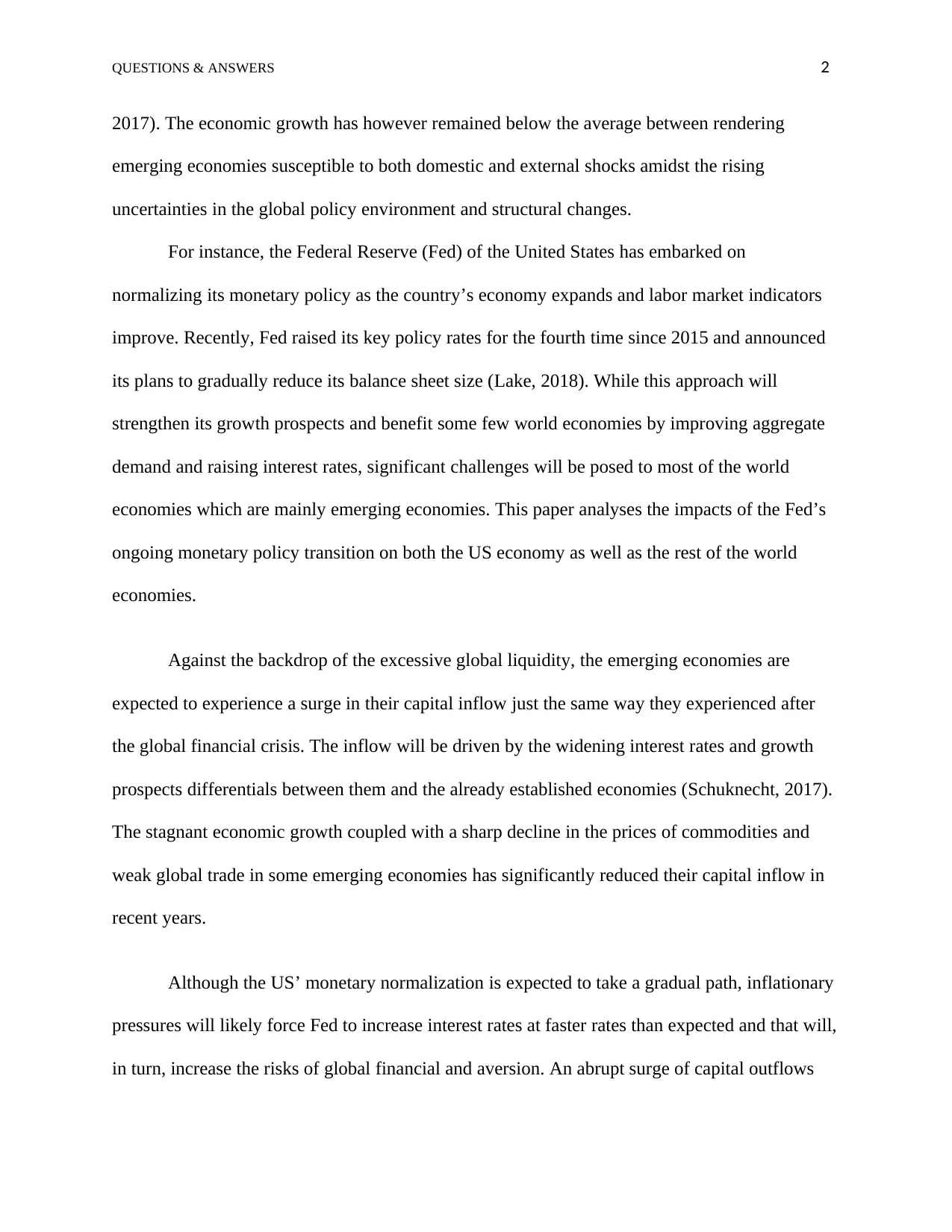
QUESTIONS & ANSWERS 2
2017). The economic growth has however remained below the average between rendering
emerging economies susceptible to both domestic and external shocks amidst the rising
uncertainties in the global policy environment and structural changes.
For instance, the Federal Reserve (Fed) of the United States has embarked on
normalizing its monetary policy as the country’s economy expands and labor market indicators
improve. Recently, Fed raised its key policy rates for the fourth time since 2015 and announced
its plans to gradually reduce its balance sheet size (Lake, 2018). While this approach will
strengthen its growth prospects and benefit some few world economies by improving aggregate
demand and raising interest rates, significant challenges will be posed to most of the world
economies which are mainly emerging economies. This paper analyses the impacts of the Fed’s
ongoing monetary policy transition on both the US economy as well as the rest of the world
economies.
Against the backdrop of the excessive global liquidity, the emerging economies are
expected to experience a surge in their capital inflow just the same way they experienced after
the global financial crisis. The inflow will be driven by the widening interest rates and growth
prospects differentials between them and the already established economies (Schuknecht, 2017).
The stagnant economic growth coupled with a sharp decline in the prices of commodities and
weak global trade in some emerging economies has significantly reduced their capital inflow in
recent years.
Although the US’ monetary normalization is expected to take a gradual path, inflationary
pressures will likely force Fed to increase interest rates at faster rates than expected and that will,
in turn, increase the risks of global financial and aversion. An abrupt surge of capital outflows
2017). The economic growth has however remained below the average between rendering
emerging economies susceptible to both domestic and external shocks amidst the rising
uncertainties in the global policy environment and structural changes.
For instance, the Federal Reserve (Fed) of the United States has embarked on
normalizing its monetary policy as the country’s economy expands and labor market indicators
improve. Recently, Fed raised its key policy rates for the fourth time since 2015 and announced
its plans to gradually reduce its balance sheet size (Lake, 2018). While this approach will
strengthen its growth prospects and benefit some few world economies by improving aggregate
demand and raising interest rates, significant challenges will be posed to most of the world
economies which are mainly emerging economies. This paper analyses the impacts of the Fed’s
ongoing monetary policy transition on both the US economy as well as the rest of the world
economies.
Against the backdrop of the excessive global liquidity, the emerging economies are
expected to experience a surge in their capital inflow just the same way they experienced after
the global financial crisis. The inflow will be driven by the widening interest rates and growth
prospects differentials between them and the already established economies (Schuknecht, 2017).
The stagnant economic growth coupled with a sharp decline in the prices of commodities and
weak global trade in some emerging economies has significantly reduced their capital inflow in
recent years.
Although the US’ monetary normalization is expected to take a gradual path, inflationary
pressures will likely force Fed to increase interest rates at faster rates than expected and that will,
in turn, increase the risks of global financial and aversion. An abrupt surge of capital outflows
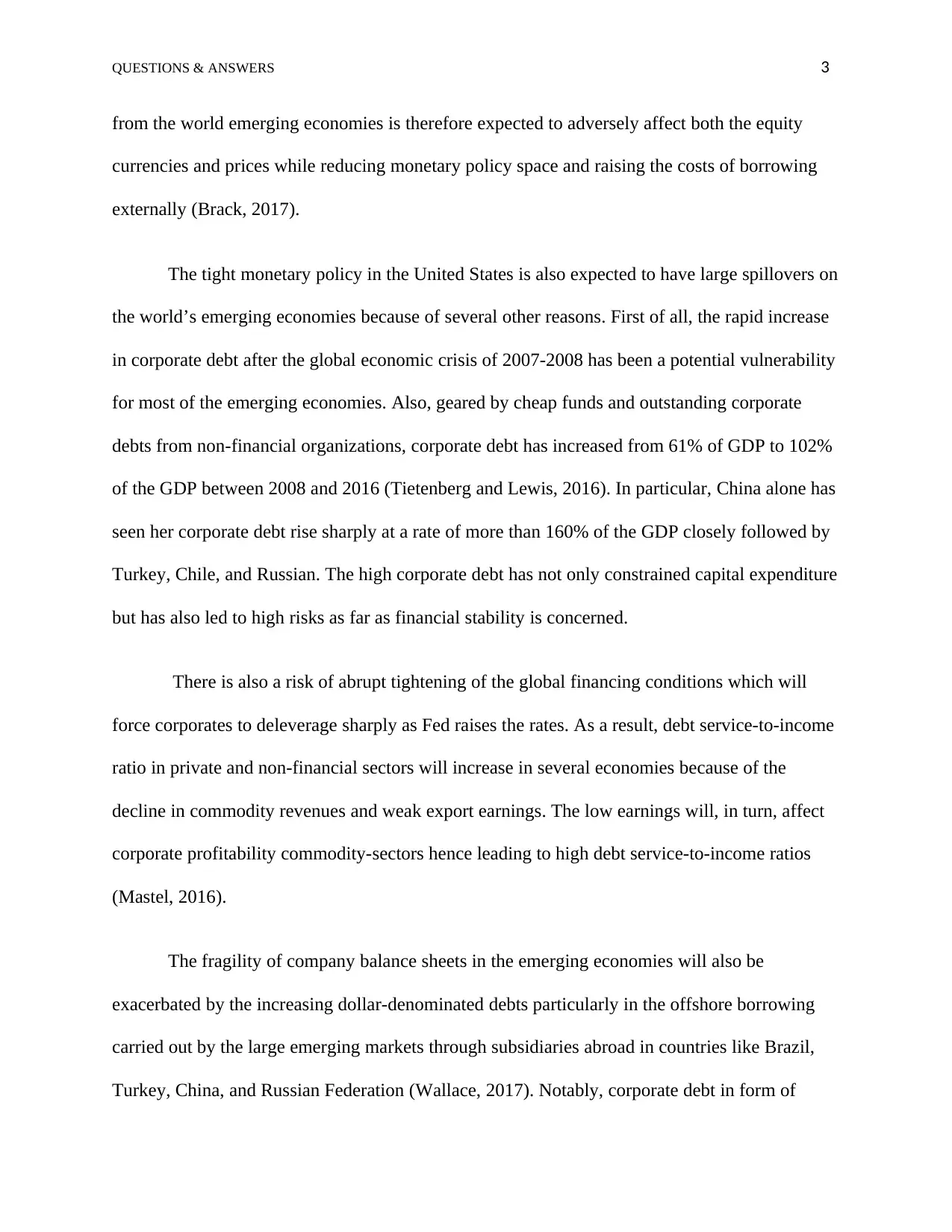
QUESTIONS & ANSWERS 3
from the world emerging economies is therefore expected to adversely affect both the equity
currencies and prices while reducing monetary policy space and raising the costs of borrowing
externally (Brack, 2017).
The tight monetary policy in the United States is also expected to have large spillovers on
the world’s emerging economies because of several other reasons. First of all, the rapid increase
in corporate debt after the global economic crisis of 2007-2008 has been a potential vulnerability
for most of the emerging economies. Also, geared by cheap funds and outstanding corporate
debts from non-financial organizations, corporate debt has increased from 61% of GDP to 102%
of the GDP between 2008 and 2016 (Tietenberg and Lewis, 2016). In particular, China alone has
seen her corporate debt rise sharply at a rate of more than 160% of the GDP closely followed by
Turkey, Chile, and Russian. The high corporate debt has not only constrained capital expenditure
but has also led to high risks as far as financial stability is concerned.
There is also a risk of abrupt tightening of the global financing conditions which will
force corporates to deleverage sharply as Fed raises the rates. As a result, debt service-to-income
ratio in private and non-financial sectors will increase in several economies because of the
decline in commodity revenues and weak export earnings. The low earnings will, in turn, affect
corporate profitability commodity-sectors hence leading to high debt service-to-income ratios
(Mastel, 2016).
The fragility of company balance sheets in the emerging economies will also be
exacerbated by the increasing dollar-denominated debts particularly in the offshore borrowing
carried out by the large emerging markets through subsidiaries abroad in countries like Brazil,
Turkey, China, and Russian Federation (Wallace, 2017). Notably, corporate debt in form of
from the world emerging economies is therefore expected to adversely affect both the equity
currencies and prices while reducing monetary policy space and raising the costs of borrowing
externally (Brack, 2017).
The tight monetary policy in the United States is also expected to have large spillovers on
the world’s emerging economies because of several other reasons. First of all, the rapid increase
in corporate debt after the global economic crisis of 2007-2008 has been a potential vulnerability
for most of the emerging economies. Also, geared by cheap funds and outstanding corporate
debts from non-financial organizations, corporate debt has increased from 61% of GDP to 102%
of the GDP between 2008 and 2016 (Tietenberg and Lewis, 2016). In particular, China alone has
seen her corporate debt rise sharply at a rate of more than 160% of the GDP closely followed by
Turkey, Chile, and Russian. The high corporate debt has not only constrained capital expenditure
but has also led to high risks as far as financial stability is concerned.
There is also a risk of abrupt tightening of the global financing conditions which will
force corporates to deleverage sharply as Fed raises the rates. As a result, debt service-to-income
ratio in private and non-financial sectors will increase in several economies because of the
decline in commodity revenues and weak export earnings. The low earnings will, in turn, affect
corporate profitability commodity-sectors hence leading to high debt service-to-income ratios
(Mastel, 2016).
The fragility of company balance sheets in the emerging economies will also be
exacerbated by the increasing dollar-denominated debts particularly in the offshore borrowing
carried out by the large emerging markets through subsidiaries abroad in countries like Brazil,
Turkey, China, and Russian Federation (Wallace, 2017). Notably, corporate debt in form of
⊘ This is a preview!⊘
Do you want full access?
Subscribe today to unlock all pages.

Trusted by 1+ million students worldwide
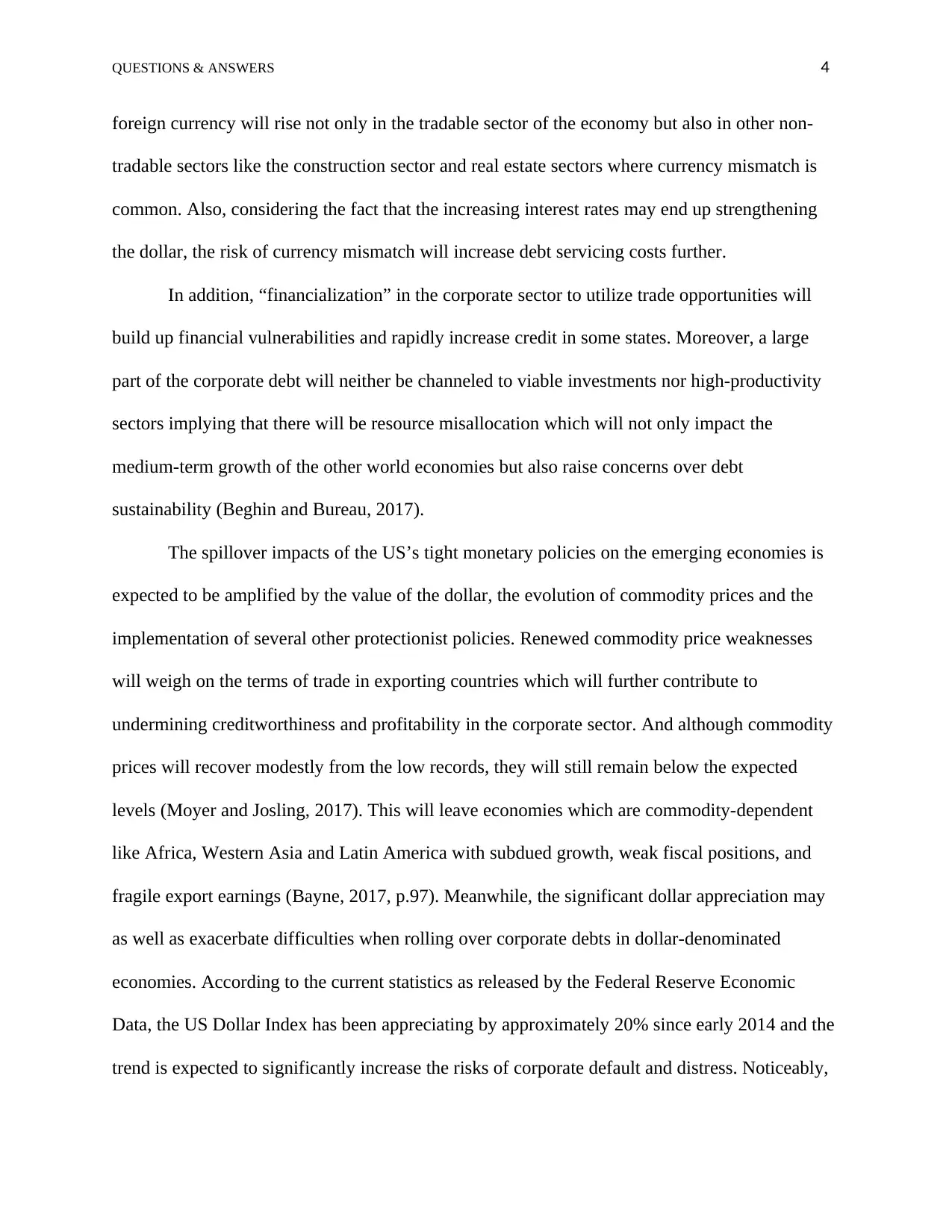
QUESTIONS & ANSWERS 4
foreign currency will rise not only in the tradable sector of the economy but also in other non-
tradable sectors like the construction sector and real estate sectors where currency mismatch is
common. Also, considering the fact that the increasing interest rates may end up strengthening
the dollar, the risk of currency mismatch will increase debt servicing costs further.
In addition, “financialization” in the corporate sector to utilize trade opportunities will
build up financial vulnerabilities and rapidly increase credit in some states. Moreover, a large
part of the corporate debt will neither be channeled to viable investments nor high-productivity
sectors implying that there will be resource misallocation which will not only impact the
medium-term growth of the other world economies but also raise concerns over debt
sustainability (Beghin and Bureau, 2017).
The spillover impacts of the US’s tight monetary policies on the emerging economies is
expected to be amplified by the value of the dollar, the evolution of commodity prices and the
implementation of several other protectionist policies. Renewed commodity price weaknesses
will weigh on the terms of trade in exporting countries which will further contribute to
undermining creditworthiness and profitability in the corporate sector. And although commodity
prices will recover modestly from the low records, they will still remain below the expected
levels (Moyer and Josling, 2017). This will leave economies which are commodity-dependent
like Africa, Western Asia and Latin America with subdued growth, weak fiscal positions, and
fragile export earnings (Bayne, 2017, p.97). Meanwhile, the significant dollar appreciation may
as well as exacerbate difficulties when rolling over corporate debts in dollar-denominated
economies. According to the current statistics as released by the Federal Reserve Economic
Data, the US Dollar Index has been appreciating by approximately 20% since early 2014 and the
trend is expected to significantly increase the risks of corporate default and distress. Noticeably,
foreign currency will rise not only in the tradable sector of the economy but also in other non-
tradable sectors like the construction sector and real estate sectors where currency mismatch is
common. Also, considering the fact that the increasing interest rates may end up strengthening
the dollar, the risk of currency mismatch will increase debt servicing costs further.
In addition, “financialization” in the corporate sector to utilize trade opportunities will
build up financial vulnerabilities and rapidly increase credit in some states. Moreover, a large
part of the corporate debt will neither be channeled to viable investments nor high-productivity
sectors implying that there will be resource misallocation which will not only impact the
medium-term growth of the other world economies but also raise concerns over debt
sustainability (Beghin and Bureau, 2017).
The spillover impacts of the US’s tight monetary policies on the emerging economies is
expected to be amplified by the value of the dollar, the evolution of commodity prices and the
implementation of several other protectionist policies. Renewed commodity price weaknesses
will weigh on the terms of trade in exporting countries which will further contribute to
undermining creditworthiness and profitability in the corporate sector. And although commodity
prices will recover modestly from the low records, they will still remain below the expected
levels (Moyer and Josling, 2017). This will leave economies which are commodity-dependent
like Africa, Western Asia and Latin America with subdued growth, weak fiscal positions, and
fragile export earnings (Bayne, 2017, p.97). Meanwhile, the significant dollar appreciation may
as well as exacerbate difficulties when rolling over corporate debts in dollar-denominated
economies. According to the current statistics as released by the Federal Reserve Economic
Data, the US Dollar Index has been appreciating by approximately 20% since early 2014 and the
trend is expected to significantly increase the risks of corporate default and distress. Noticeably,
Paraphrase This Document
Need a fresh take? Get an instant paraphrase of this document with our AI Paraphraser
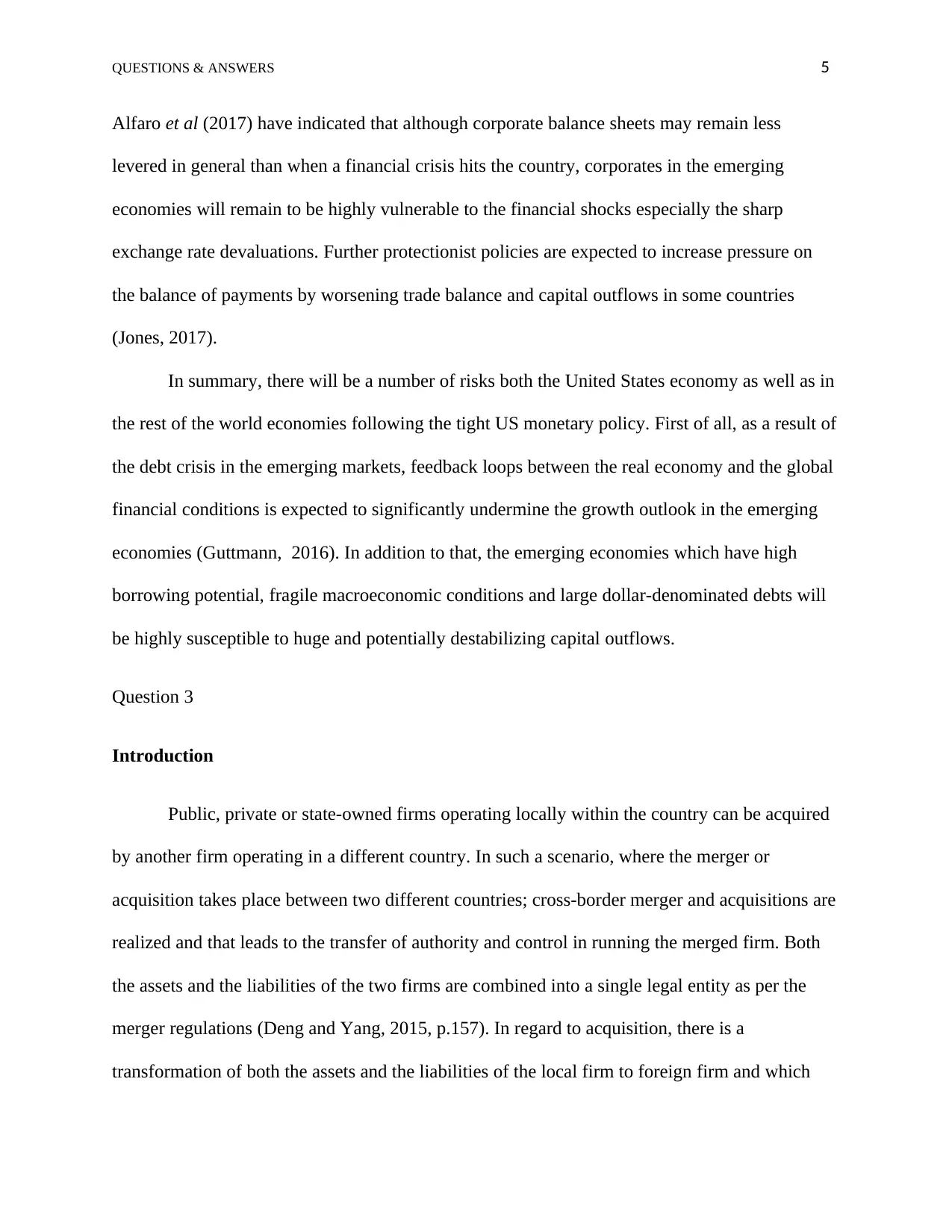
QUESTIONS & ANSWERS 5
Alfaro et al (2017) have indicated that although corporate balance sheets may remain less
levered in general than when a financial crisis hits the country, corporates in the emerging
economies will remain to be highly vulnerable to the financial shocks especially the sharp
exchange rate devaluations. Further protectionist policies are expected to increase pressure on
the balance of payments by worsening trade balance and capital outflows in some countries
(Jones, 2017).
In summary, there will be a number of risks both the United States economy as well as in
the rest of the world economies following the tight US monetary policy. First of all, as a result of
the debt crisis in the emerging markets, feedback loops between the real economy and the global
financial conditions is expected to significantly undermine the growth outlook in the emerging
economies (Guttmann, 2016). In addition to that, the emerging economies which have high
borrowing potential, fragile macroeconomic conditions and large dollar-denominated debts will
be highly susceptible to huge and potentially destabilizing capital outflows.
Question 3
Introduction
Public, private or state-owned firms operating locally within the country can be acquired
by another firm operating in a different country. In such a scenario, where the merger or
acquisition takes place between two different countries; cross-border merger and acquisitions are
realized and that leads to the transfer of authority and control in running the merged firm. Both
the assets and the liabilities of the two firms are combined into a single legal entity as per the
merger regulations (Deng and Yang, 2015, p.157). In regard to acquisition, there is a
transformation of both the assets and the liabilities of the local firm to foreign firm and which
Alfaro et al (2017) have indicated that although corporate balance sheets may remain less
levered in general than when a financial crisis hits the country, corporates in the emerging
economies will remain to be highly vulnerable to the financial shocks especially the sharp
exchange rate devaluations. Further protectionist policies are expected to increase pressure on
the balance of payments by worsening trade balance and capital outflows in some countries
(Jones, 2017).
In summary, there will be a number of risks both the United States economy as well as in
the rest of the world economies following the tight US monetary policy. First of all, as a result of
the debt crisis in the emerging markets, feedback loops between the real economy and the global
financial conditions is expected to significantly undermine the growth outlook in the emerging
economies (Guttmann, 2016). In addition to that, the emerging economies which have high
borrowing potential, fragile macroeconomic conditions and large dollar-denominated debts will
be highly susceptible to huge and potentially destabilizing capital outflows.
Question 3
Introduction
Public, private or state-owned firms operating locally within the country can be acquired
by another firm operating in a different country. In such a scenario, where the merger or
acquisition takes place between two different countries; cross-border merger and acquisitions are
realized and that leads to the transfer of authority and control in running the merged firm. Both
the assets and the liabilities of the two firms are combined into a single legal entity as per the
merger regulations (Deng and Yang, 2015, p.157). In regard to acquisition, there is a
transformation of both the assets and the liabilities of the local firm to foreign firm and which

QUESTIONS & ANSWERS 6
leads to an automatic affiliation of the local firm. Since cross border, M&As involve two
countries, the state where the firm that makes the acquisition originated is referred to as a home
country whereas the country where the targeted firm is located is referred to as the host country.
The headquarters of the newly established firm can be in the two countries (Ahammad, Tarba,
Liu and Glaister, 2016, p.70). A good example is a merger between Dutch Royal Shell which has
its headquarters both in Netherlands and United Kingdom. The headquarters of a merger can also
be in the Home country, like the merger between Daimler-Benz AG and Chrysler Corporation
whose headquarters are in Germany.
Factors Influencing Pace & Pattern of Cross-Border M&As
The underlying factors that influence Cross Border Mergers &Acquisitions by large firms
today have been closely linked with the current trends of globalization. According to the World
Investment Reports released between the year 2000 and 2009, Cross Border Mergers
&Acquisitions indicated an increasing trend from 1990 until 2005 (Ahammad et al, 2017, p.180).
In 2008 however, the trend reversed registering a decrease both in quantity and value as a result
of the global economic crisis. In support of these findings, prospectus World Investment Reports
of 2009 indicated that Cross Border M&As continued to increase in some regions like Asia
where the global economic crisis had fewer impacts. There are a number of motives underlying
the expansion of cross border M&As which include (Ahammad et al, 2016, p.445): increasing
profitability and enhancing revenue, reducing costs, expanding markets, and to gaining power
and efficiency. There are various factors that have influenced the pace and pattern of cross
border M&As as discussed below:
The Synergy factor
leads to an automatic affiliation of the local firm. Since cross border, M&As involve two
countries, the state where the firm that makes the acquisition originated is referred to as a home
country whereas the country where the targeted firm is located is referred to as the host country.
The headquarters of the newly established firm can be in the two countries (Ahammad, Tarba,
Liu and Glaister, 2016, p.70). A good example is a merger between Dutch Royal Shell which has
its headquarters both in Netherlands and United Kingdom. The headquarters of a merger can also
be in the Home country, like the merger between Daimler-Benz AG and Chrysler Corporation
whose headquarters are in Germany.
Factors Influencing Pace & Pattern of Cross-Border M&As
The underlying factors that influence Cross Border Mergers &Acquisitions by large firms
today have been closely linked with the current trends of globalization. According to the World
Investment Reports released between the year 2000 and 2009, Cross Border Mergers
&Acquisitions indicated an increasing trend from 1990 until 2005 (Ahammad et al, 2017, p.180).
In 2008 however, the trend reversed registering a decrease both in quantity and value as a result
of the global economic crisis. In support of these findings, prospectus World Investment Reports
of 2009 indicated that Cross Border M&As continued to increase in some regions like Asia
where the global economic crisis had fewer impacts. There are a number of motives underlying
the expansion of cross border M&As which include (Ahammad et al, 2016, p.445): increasing
profitability and enhancing revenue, reducing costs, expanding markets, and to gaining power
and efficiency. There are various factors that have influenced the pace and pattern of cross
border M&As as discussed below:
The Synergy factor
⊘ This is a preview!⊘
Do you want full access?
Subscribe today to unlock all pages.

Trusted by 1+ million students worldwide

QUESTIONS & ANSWERS 7
Research has indicated that when different firms combine their business activities their
performance tends to increase while the operational cost decreases. This does not always hold
true in all the industries because there are some of the industries where synergy will not lead to
reduced costs of operations (Buckley et al, 2016, p.425). Mainly, foreign firms which mutually
depend on each other in terms of raw materials have shown great potential in establishing cross-
border mergers and acquisitions because this leads to improved performance and reduced costs.
For instance, if a foreign company A depends on raw materials from another company B
operating in a different country, as a result of the two companies merging, company A will not
need to look for vendors or outsource raw materials for its operations (Mescall and Klassen,
2018, p.830). On the other hand, company B doesn’t need to worry about sales and marketing
because company A has roots in the sector. From this scenario, it comes out clearly that when the
two companies merge, their performance will increase and cost of operation decrease. For that
matter, industries, where there is potential synergy, have influenced cross-border mergers and
acquisitions.
Diversification/ sharpening business focus factor
In the dawn of globalization, business organizations are seeking to penetrate into
potential markets in different ways. Among the approaches is merging and acquiring firms
operating in the country of target (Alimov and Officer, 2017, p.360). Through merging and
acquiring a company operating in another country, a company manages to penetrate into the
country’s market. For instance, a company whose end products are raw materials for another
foreign company will merge and acquire a small company within that country with an aim of
Research has indicated that when different firms combine their business activities their
performance tends to increase while the operational cost decreases. This does not always hold
true in all the industries because there are some of the industries where synergy will not lead to
reduced costs of operations (Buckley et al, 2016, p.425). Mainly, foreign firms which mutually
depend on each other in terms of raw materials have shown great potential in establishing cross-
border mergers and acquisitions because this leads to improved performance and reduced costs.
For instance, if a foreign company A depends on raw materials from another company B
operating in a different country, as a result of the two companies merging, company A will not
need to look for vendors or outsource raw materials for its operations (Mescall and Klassen,
2018, p.830). On the other hand, company B doesn’t need to worry about sales and marketing
because company A has roots in the sector. From this scenario, it comes out clearly that when the
two companies merge, their performance will increase and cost of operation decrease. For that
matter, industries, where there is potential synergy, have influenced cross-border mergers and
acquisitions.
Diversification/ sharpening business focus factor
In the dawn of globalization, business organizations are seeking to penetrate into
potential markets in different ways. Among the approaches is merging and acquiring firms
operating in the country of target (Alimov and Officer, 2017, p.360). Through merging and
acquiring a company operating in another country, a company manages to penetrate into the
country’s market. For instance, a company whose end products are raw materials for another
foreign company will merge and acquire a small company within that country with an aim of
Paraphrase This Document
Need a fresh take? Get an instant paraphrase of this document with our AI Paraphraser
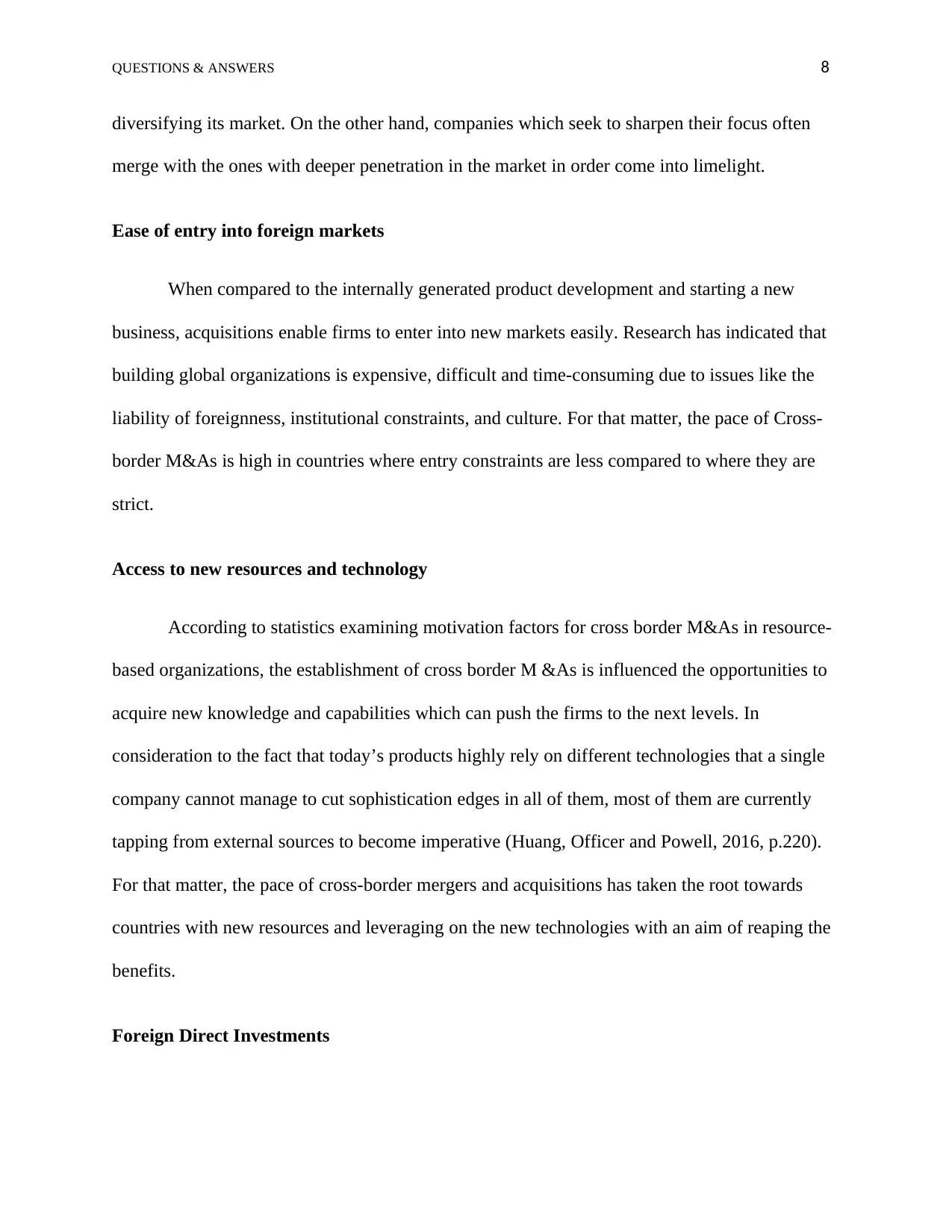
QUESTIONS & ANSWERS 8
diversifying its market. On the other hand, companies which seek to sharpen their focus often
merge with the ones with deeper penetration in the market in order come into limelight.
Ease of entry into foreign markets
When compared to the internally generated product development and starting a new
business, acquisitions enable firms to enter into new markets easily. Research has indicated that
building global organizations is expensive, difficult and time-consuming due to issues like the
liability of foreignness, institutional constraints, and culture. For that matter, the pace of Cross-
border M&As is high in countries where entry constraints are less compared to where they are
strict.
Access to new resources and technology
According to statistics examining motivation factors for cross border M&As in resource-
based organizations, the establishment of cross border M &As is influenced the opportunities to
acquire new knowledge and capabilities which can push the firms to the next levels. In
consideration to the fact that today’s products highly rely on different technologies that a single
company cannot manage to cut sophistication edges in all of them, most of them are currently
tapping from external sources to become imperative (Huang, Officer and Powell, 2016, p.220).
For that matter, the pace of cross-border mergers and acquisitions has taken the root towards
countries with new resources and leveraging on the new technologies with an aim of reaping the
benefits.
Foreign Direct Investments
diversifying its market. On the other hand, companies which seek to sharpen their focus often
merge with the ones with deeper penetration in the market in order come into limelight.
Ease of entry into foreign markets
When compared to the internally generated product development and starting a new
business, acquisitions enable firms to enter into new markets easily. Research has indicated that
building global organizations is expensive, difficult and time-consuming due to issues like the
liability of foreignness, institutional constraints, and culture. For that matter, the pace of Cross-
border M&As is high in countries where entry constraints are less compared to where they are
strict.
Access to new resources and technology
According to statistics examining motivation factors for cross border M&As in resource-
based organizations, the establishment of cross border M &As is influenced the opportunities to
acquire new knowledge and capabilities which can push the firms to the next levels. In
consideration to the fact that today’s products highly rely on different technologies that a single
company cannot manage to cut sophistication edges in all of them, most of them are currently
tapping from external sources to become imperative (Huang, Officer and Powell, 2016, p.220).
For that matter, the pace of cross-border mergers and acquisitions has taken the root towards
countries with new resources and leveraging on the new technologies with an aim of reaping the
benefits.
Foreign Direct Investments
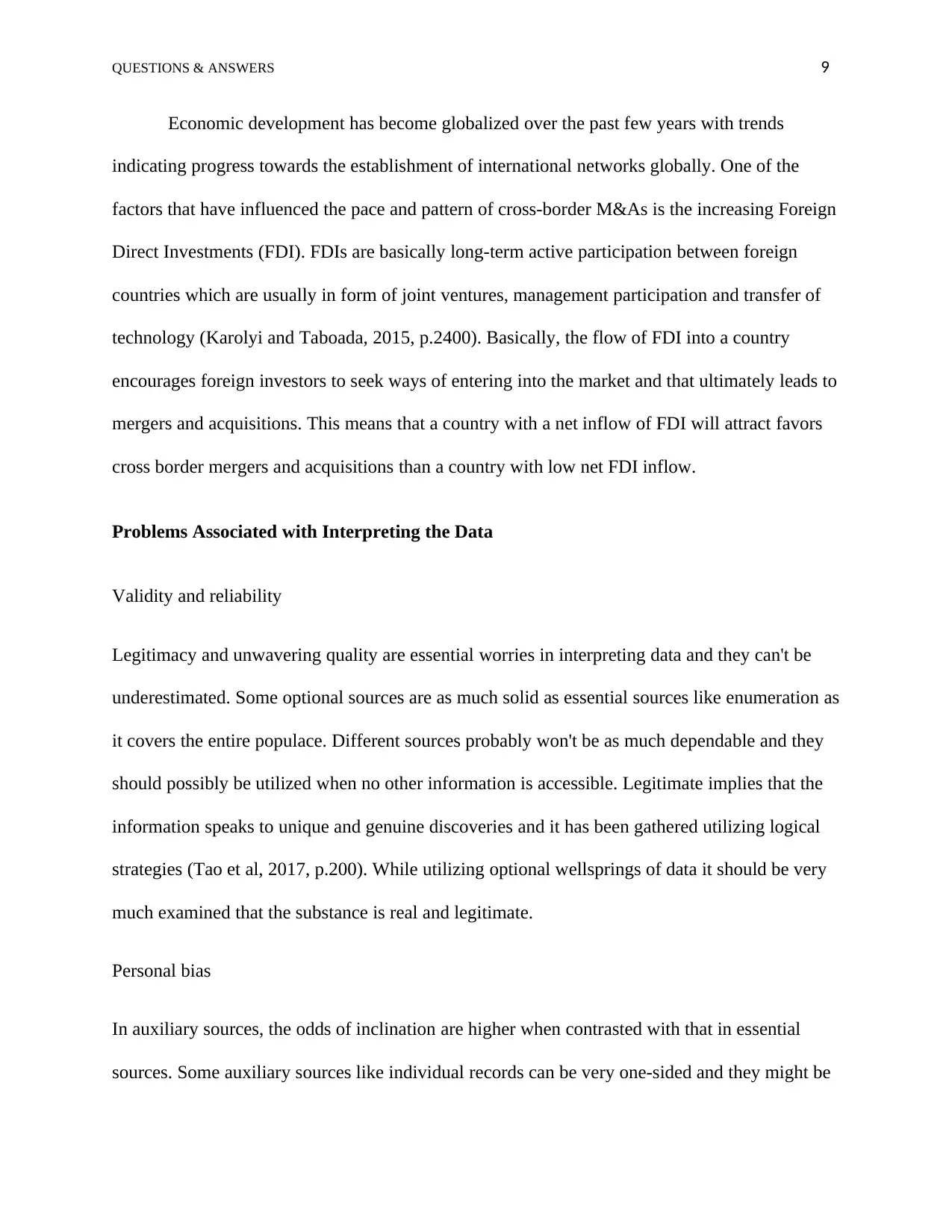
QUESTIONS & ANSWERS 9
Economic development has become globalized over the past few years with trends
indicating progress towards the establishment of international networks globally. One of the
factors that have influenced the pace and pattern of cross-border M&As is the increasing Foreign
Direct Investments (FDI). FDIs are basically long-term active participation between foreign
countries which are usually in form of joint ventures, management participation and transfer of
technology (Karolyi and Taboada, 2015, p.2400). Basically, the flow of FDI into a country
encourages foreign investors to seek ways of entering into the market and that ultimately leads to
mergers and acquisitions. This means that a country with a net inflow of FDI will attract favors
cross border mergers and acquisitions than a country with low net FDI inflow.
Problems Associated with Interpreting the Data
Validity and reliability
Legitimacy and unwavering quality are essential worries in interpreting data and they can't be
underestimated. Some optional sources are as much solid as essential sources like enumeration as
it covers the entire populace. Different sources probably won't be as much dependable and they
should possibly be utilized when no other information is accessible. Legitimate implies that the
information speaks to unique and genuine discoveries and it has been gathered utilizing logical
strategies (Tao et al, 2017, p.200). While utilizing optional wellsprings of data it should be very
much examined that the substance is real and legitimate.
Personal bias
In auxiliary sources, the odds of inclination are higher when contrasted with that in essential
sources. Some auxiliary sources like individual records can be very one-sided and they might be
Economic development has become globalized over the past few years with trends
indicating progress towards the establishment of international networks globally. One of the
factors that have influenced the pace and pattern of cross-border M&As is the increasing Foreign
Direct Investments (FDI). FDIs are basically long-term active participation between foreign
countries which are usually in form of joint ventures, management participation and transfer of
technology (Karolyi and Taboada, 2015, p.2400). Basically, the flow of FDI into a country
encourages foreign investors to seek ways of entering into the market and that ultimately leads to
mergers and acquisitions. This means that a country with a net inflow of FDI will attract favors
cross border mergers and acquisitions than a country with low net FDI inflow.
Problems Associated with Interpreting the Data
Validity and reliability
Legitimacy and unwavering quality are essential worries in interpreting data and they can't be
underestimated. Some optional sources are as much solid as essential sources like enumeration as
it covers the entire populace. Different sources probably won't be as much dependable and they
should possibly be utilized when no other information is accessible. Legitimate implies that the
information speaks to unique and genuine discoveries and it has been gathered utilizing logical
strategies (Tao et al, 2017, p.200). While utilizing optional wellsprings of data it should be very
much examined that the substance is real and legitimate.
Personal bias
In auxiliary sources, the odds of inclination are higher when contrasted with that in essential
sources. Some auxiliary sources like individual records can be very one-sided and they might be
⊘ This is a preview!⊘
Do you want full access?
Subscribe today to unlock all pages.

Trusted by 1+ million students worldwide
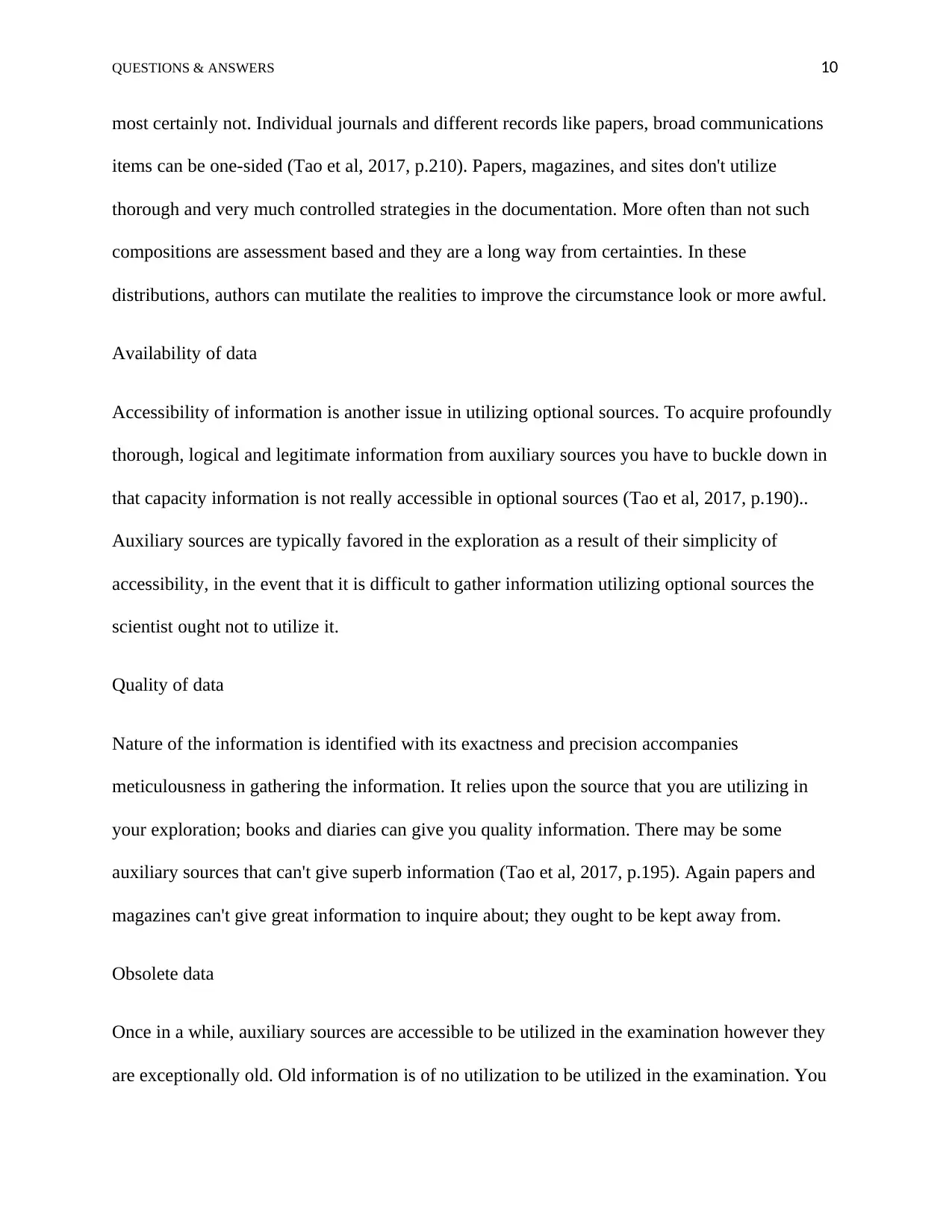
QUESTIONS & ANSWERS 10
most certainly not. Individual journals and different records like papers, broad communications
items can be one-sided (Tao et al, 2017, p.210). Papers, magazines, and sites don't utilize
thorough and very much controlled strategies in the documentation. More often than not such
compositions are assessment based and they are a long way from certainties. In these
distributions, authors can mutilate the realities to improve the circumstance look or more awful.
Availability of data
Accessibility of information is another issue in utilizing optional sources. To acquire profoundly
thorough, logical and legitimate information from auxiliary sources you have to buckle down in
that capacity information is not really accessible in optional sources (Tao et al, 2017, p.190)..
Auxiliary sources are typically favored in the exploration as a result of their simplicity of
accessibility, in the event that it is difficult to gather information utilizing optional sources the
scientist ought not to utilize it.
Quality of data
Nature of the information is identified with its exactness and precision accompanies
meticulousness in gathering the information. It relies upon the source that you are utilizing in
your exploration; books and diaries can give you quality information. There may be some
auxiliary sources that can't give superb information (Tao et al, 2017, p.195). Again papers and
magazines can't give great information to inquire about; they ought to be kept away from.
Obsolete data
Once in a while, auxiliary sources are accessible to be utilized in the examination however they
are exceptionally old. Old information is of no utilization to be utilized in the examination. You
most certainly not. Individual journals and different records like papers, broad communications
items can be one-sided (Tao et al, 2017, p.210). Papers, magazines, and sites don't utilize
thorough and very much controlled strategies in the documentation. More often than not such
compositions are assessment based and they are a long way from certainties. In these
distributions, authors can mutilate the realities to improve the circumstance look or more awful.
Availability of data
Accessibility of information is another issue in utilizing optional sources. To acquire profoundly
thorough, logical and legitimate information from auxiliary sources you have to buckle down in
that capacity information is not really accessible in optional sources (Tao et al, 2017, p.190)..
Auxiliary sources are typically favored in the exploration as a result of their simplicity of
accessibility, in the event that it is difficult to gather information utilizing optional sources the
scientist ought not to utilize it.
Quality of data
Nature of the information is identified with its exactness and precision accompanies
meticulousness in gathering the information. It relies upon the source that you are utilizing in
your exploration; books and diaries can give you quality information. There may be some
auxiliary sources that can't give superb information (Tao et al, 2017, p.195). Again papers and
magazines can't give great information to inquire about; they ought to be kept away from.
Obsolete data
Once in a while, auxiliary sources are accessible to be utilized in the examination however they
are exceptionally old. Old information is of no utilization to be utilized in the examination. You
Paraphrase This Document
Need a fresh take? Get an instant paraphrase of this document with our AI Paraphraser
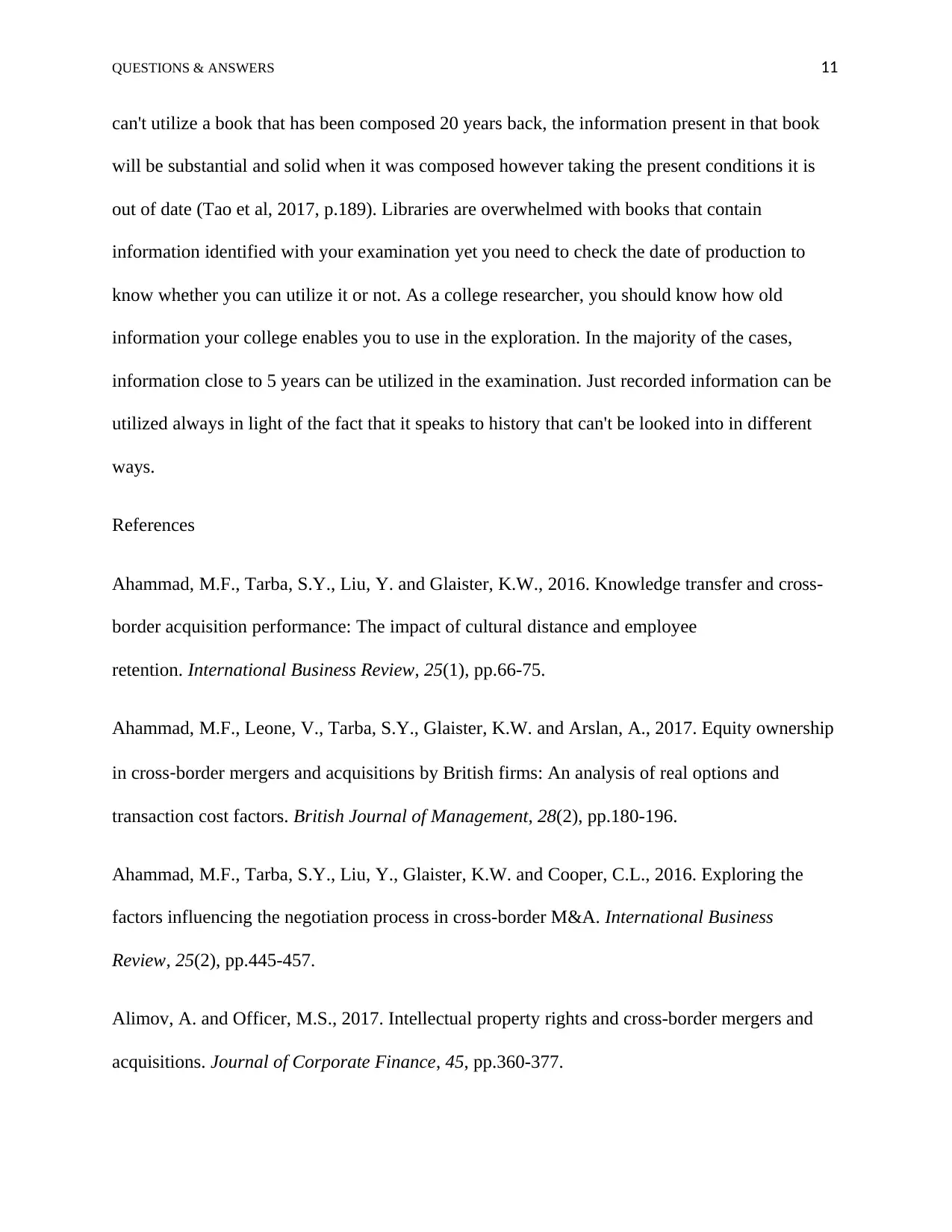
QUESTIONS & ANSWERS 11
can't utilize a book that has been composed 20 years back, the information present in that book
will be substantial and solid when it was composed however taking the present conditions it is
out of date (Tao et al, 2017, p.189). Libraries are overwhelmed with books that contain
information identified with your examination yet you need to check the date of production to
know whether you can utilize it or not. As a college researcher, you should know how old
information your college enables you to use in the exploration. In the majority of the cases,
information close to 5 years can be utilized in the examination. Just recorded information can be
utilized always in light of the fact that it speaks to history that can't be looked into in different
ways.
References
Ahammad, M.F., Tarba, S.Y., Liu, Y. and Glaister, K.W., 2016. Knowledge transfer and cross-
border acquisition performance: The impact of cultural distance and employee
retention. International Business Review, 25(1), pp.66-75.
Ahammad, M.F., Leone, V., Tarba, S.Y., Glaister, K.W. and Arslan, A., 2017. Equity ownership
in cross‐border mergers and acquisitions by British firms: An analysis of real options and
transaction cost factors. British Journal of Management, 28(2), pp.180-196.
Ahammad, M.F., Tarba, S.Y., Liu, Y., Glaister, K.W. and Cooper, C.L., 2016. Exploring the
factors influencing the negotiation process in cross-border M&A. International Business
Review, 25(2), pp.445-457.
Alimov, A. and Officer, M.S., 2017. Intellectual property rights and cross-border mergers and
acquisitions. Journal of Corporate Finance, 45, pp.360-377.
can't utilize a book that has been composed 20 years back, the information present in that book
will be substantial and solid when it was composed however taking the present conditions it is
out of date (Tao et al, 2017, p.189). Libraries are overwhelmed with books that contain
information identified with your examination yet you need to check the date of production to
know whether you can utilize it or not. As a college researcher, you should know how old
information your college enables you to use in the exploration. In the majority of the cases,
information close to 5 years can be utilized in the examination. Just recorded information can be
utilized always in light of the fact that it speaks to history that can't be looked into in different
ways.
References
Ahammad, M.F., Tarba, S.Y., Liu, Y. and Glaister, K.W., 2016. Knowledge transfer and cross-
border acquisition performance: The impact of cultural distance and employee
retention. International Business Review, 25(1), pp.66-75.
Ahammad, M.F., Leone, V., Tarba, S.Y., Glaister, K.W. and Arslan, A., 2017. Equity ownership
in cross‐border mergers and acquisitions by British firms: An analysis of real options and
transaction cost factors. British Journal of Management, 28(2), pp.180-196.
Ahammad, M.F., Tarba, S.Y., Liu, Y., Glaister, K.W. and Cooper, C.L., 2016. Exploring the
factors influencing the negotiation process in cross-border M&A. International Business
Review, 25(2), pp.445-457.
Alimov, A. and Officer, M.S., 2017. Intellectual property rights and cross-border mergers and
acquisitions. Journal of Corporate Finance, 45, pp.360-377.
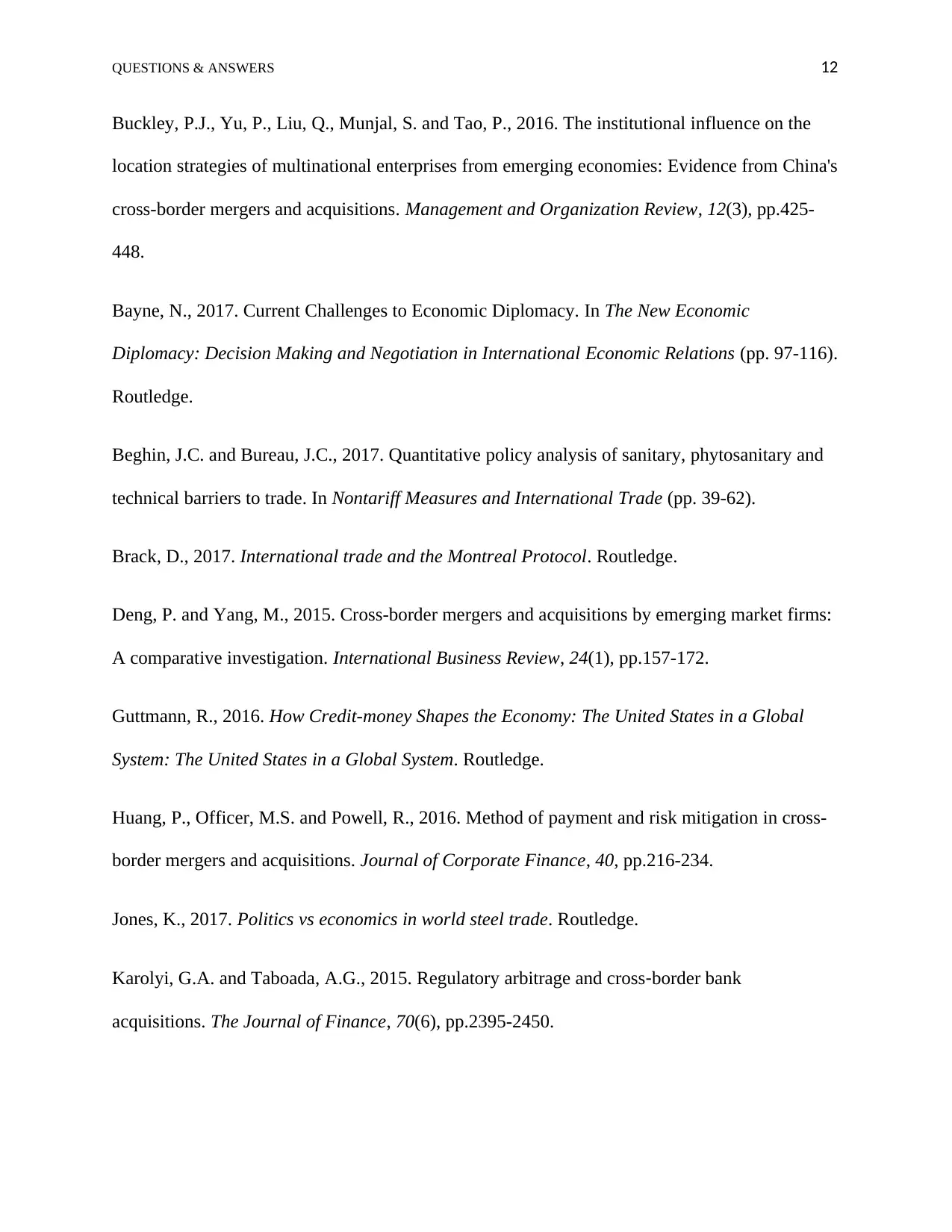
QUESTIONS & ANSWERS 12
Buckley, P.J., Yu, P., Liu, Q., Munjal, S. and Tao, P., 2016. The institutional influence on the
location strategies of multinational enterprises from emerging economies: Evidence from China's
cross-border mergers and acquisitions. Management and Organization Review, 12(3), pp.425-
448.
Bayne, N., 2017. Current Challenges to Economic Diplomacy. In The New Economic
Diplomacy: Decision Making and Negotiation in International Economic Relations (pp. 97-116).
Routledge.
Beghin, J.C. and Bureau, J.C., 2017. Quantitative policy analysis of sanitary, phytosanitary and
technical barriers to trade. In Nontariff Measures and International Trade (pp. 39-62).
Brack, D., 2017. International trade and the Montreal Protocol. Routledge.
Deng, P. and Yang, M., 2015. Cross-border mergers and acquisitions by emerging market firms:
A comparative investigation. International Business Review, 24(1), pp.157-172.
Guttmann, R., 2016. How Credit-money Shapes the Economy: The United States in a Global
System: The United States in a Global System. Routledge.
Huang, P., Officer, M.S. and Powell, R., 2016. Method of payment and risk mitigation in cross-
border mergers and acquisitions. Journal of Corporate Finance, 40, pp.216-234.
Jones, K., 2017. Politics vs economics in world steel trade. Routledge.
Karolyi, G.A. and Taboada, A.G., 2015. Regulatory arbitrage and cross‐border bank
acquisitions. The Journal of Finance, 70(6), pp.2395-2450.
Buckley, P.J., Yu, P., Liu, Q., Munjal, S. and Tao, P., 2016. The institutional influence on the
location strategies of multinational enterprises from emerging economies: Evidence from China's
cross-border mergers and acquisitions. Management and Organization Review, 12(3), pp.425-
448.
Bayne, N., 2017. Current Challenges to Economic Diplomacy. In The New Economic
Diplomacy: Decision Making and Negotiation in International Economic Relations (pp. 97-116).
Routledge.
Beghin, J.C. and Bureau, J.C., 2017. Quantitative policy analysis of sanitary, phytosanitary and
technical barriers to trade. In Nontariff Measures and International Trade (pp. 39-62).
Brack, D., 2017. International trade and the Montreal Protocol. Routledge.
Deng, P. and Yang, M., 2015. Cross-border mergers and acquisitions by emerging market firms:
A comparative investigation. International Business Review, 24(1), pp.157-172.
Guttmann, R., 2016. How Credit-money Shapes the Economy: The United States in a Global
System: The United States in a Global System. Routledge.
Huang, P., Officer, M.S. and Powell, R., 2016. Method of payment and risk mitigation in cross-
border mergers and acquisitions. Journal of Corporate Finance, 40, pp.216-234.
Jones, K., 2017. Politics vs economics in world steel trade. Routledge.
Karolyi, G.A. and Taboada, A.G., 2015. Regulatory arbitrage and cross‐border bank
acquisitions. The Journal of Finance, 70(6), pp.2395-2450.
⊘ This is a preview!⊘
Do you want full access?
Subscribe today to unlock all pages.

Trusted by 1+ million students worldwide
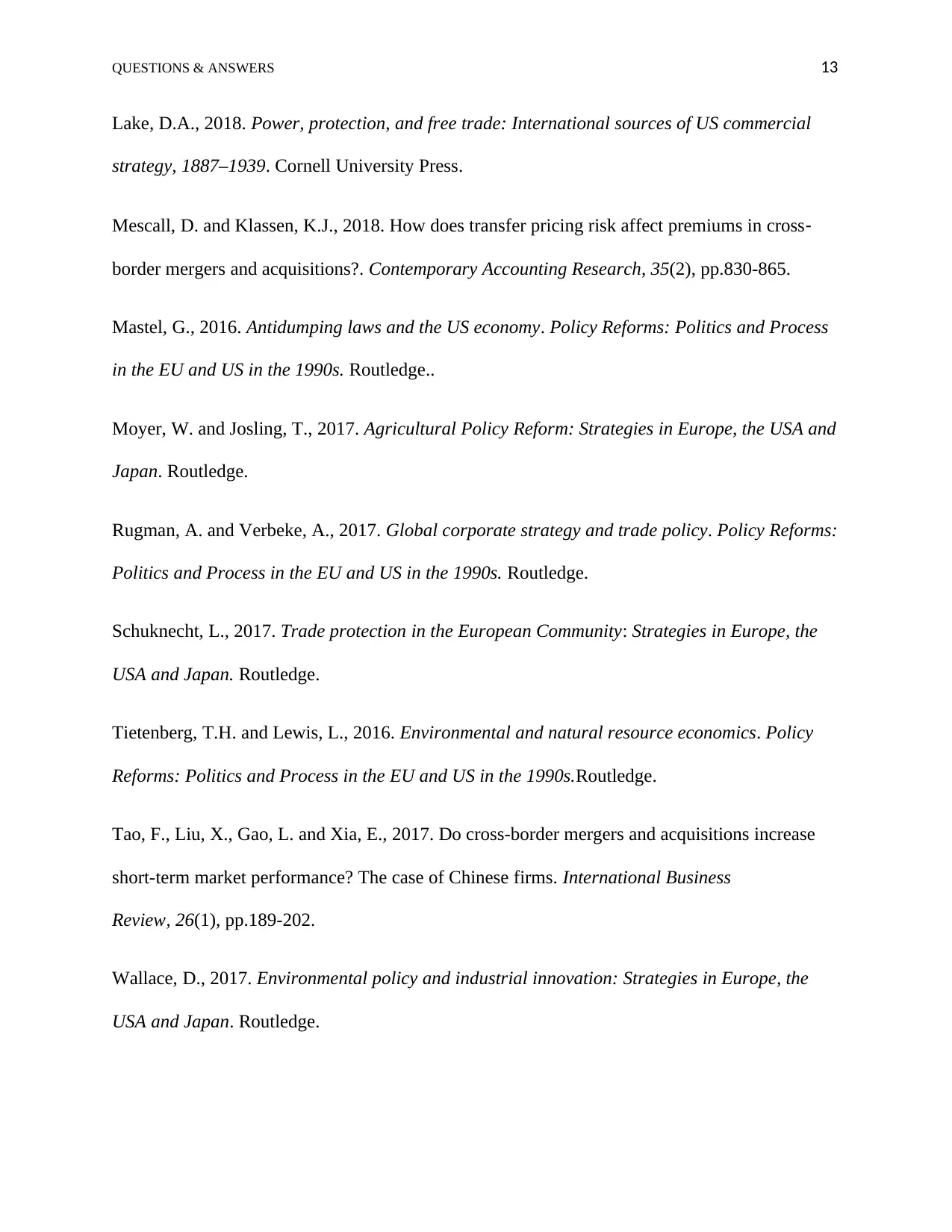
QUESTIONS & ANSWERS 13
Lake, D.A., 2018. Power, protection, and free trade: International sources of US commercial
strategy, 1887–1939. Cornell University Press.
Mescall, D. and Klassen, K.J., 2018. How does transfer pricing risk affect premiums in cross‐
border mergers and acquisitions?. Contemporary Accounting Research, 35(2), pp.830-865.
Mastel, G., 2016. Antidumping laws and the US economy. Policy Reforms: Politics and Process
in the EU and US in the 1990s. Routledge..
Moyer, W. and Josling, T., 2017. Agricultural Policy Reform: Strategies in Europe, the USA and
Japan. Routledge.
Rugman, A. and Verbeke, A., 2017. Global corporate strategy and trade policy. Policy Reforms:
Politics and Process in the EU and US in the 1990s. Routledge.
Schuknecht, L., 2017. Trade protection in the European Community: Strategies in Europe, the
USA and Japan. Routledge.
Tietenberg, T.H. and Lewis, L., 2016. Environmental and natural resource economics. Policy
Reforms: Politics and Process in the EU and US in the 1990s.Routledge.
Tao, F., Liu, X., Gao, L. and Xia, E., 2017. Do cross-border mergers and acquisitions increase
short-term market performance? The case of Chinese firms. International Business
Review, 26(1), pp.189-202.
Wallace, D., 2017. Environmental policy and industrial innovation: Strategies in Europe, the
USA and Japan. Routledge.
Lake, D.A., 2018. Power, protection, and free trade: International sources of US commercial
strategy, 1887–1939. Cornell University Press.
Mescall, D. and Klassen, K.J., 2018. How does transfer pricing risk affect premiums in cross‐
border mergers and acquisitions?. Contemporary Accounting Research, 35(2), pp.830-865.
Mastel, G., 2016. Antidumping laws and the US economy. Policy Reforms: Politics and Process
in the EU and US in the 1990s. Routledge..
Moyer, W. and Josling, T., 2017. Agricultural Policy Reform: Strategies in Europe, the USA and
Japan. Routledge.
Rugman, A. and Verbeke, A., 2017. Global corporate strategy and trade policy. Policy Reforms:
Politics and Process in the EU and US in the 1990s. Routledge.
Schuknecht, L., 2017. Trade protection in the European Community: Strategies in Europe, the
USA and Japan. Routledge.
Tietenberg, T.H. and Lewis, L., 2016. Environmental and natural resource economics. Policy
Reforms: Politics and Process in the EU and US in the 1990s.Routledge.
Tao, F., Liu, X., Gao, L. and Xia, E., 2017. Do cross-border mergers and acquisitions increase
short-term market performance? The case of Chinese firms. International Business
Review, 26(1), pp.189-202.
Wallace, D., 2017. Environmental policy and industrial innovation: Strategies in Europe, the
USA and Japan. Routledge.
Paraphrase This Document
Need a fresh take? Get an instant paraphrase of this document with our AI Paraphraser

QUESTIONS & ANSWERS 14
1 out of 14
Related Documents
Your All-in-One AI-Powered Toolkit for Academic Success.
+13062052269
info@desklib.com
Available 24*7 on WhatsApp / Email
![[object Object]](/_next/static/media/star-bottom.7253800d.svg)
Unlock your academic potential
© 2024 | Zucol Services PVT LTD | All rights reserved.





